RISING STORM - THE IMPERIAL JAPANESE NAVY AND
CHINA
1931-1941
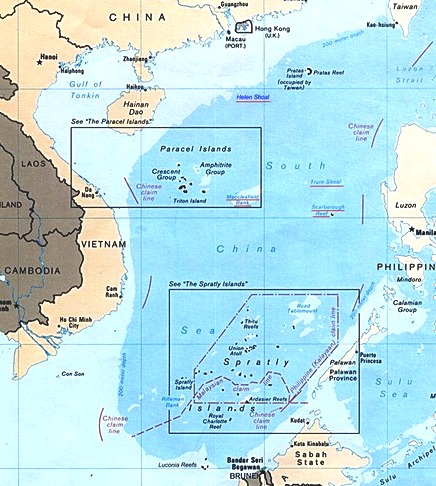 Location of the Pratas, Paracel and Spratly Islands in the South China
Sea
Location of the Pratas, Paracel and Spratly Islands in the South China
Sea
Japanese Occupation South China Sea Islands - 1937-1941
© 2012 Bob Hackett, Sander Kingsepp and Anthony Tully
Revision 1
206 BC-220 AD:
Han Dynasty. Chinese traders conduct maritime commerce in the South China Sea.
1368-1644:
Ming Dynasty. Chinese traders transit the South China Sea regularly enroute to the Malay port of Malacca and the Indian Ocean.
1644-1911:
During the Qing Dynasty, a flourishing trade is established between East and West traders. The South China Sea is dominated by Chinese junks
and Western merchantmen.
1887:
Paracels. As a result of the Sino-French conflict in 1884-1885, France makes Annam a protectorate and later a colony of French Indochina. The French build a light house on the Paracel (Xisha) Islands which consist of thirty or so, mostly uninhabitated, islets and reefs. [1]
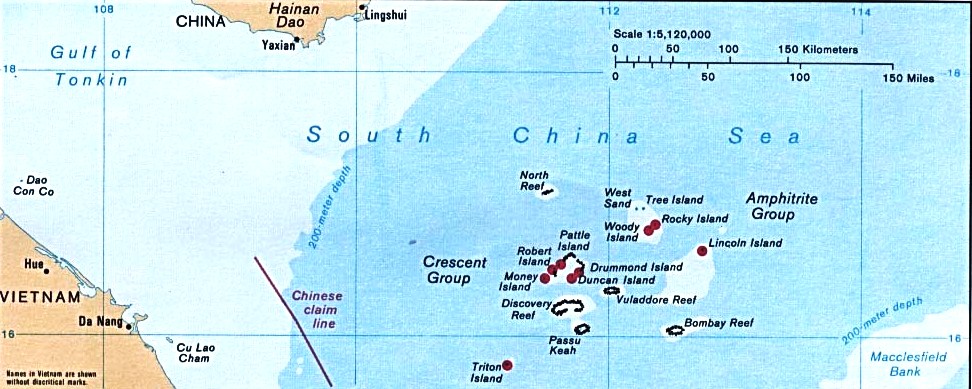 Detail of the Paracel Islands showing Wood and Robert Islands
Detail of the Paracel Islands showing Wood and Robert Islands
1909-1910:
Paracels. China lands troops in the Paracels and annexes many of the islands under Guangdong Province. Thereafter, each year China sends a ship to the Paracels.
1920s:
Paracels. Mitsui Bussan Kaisha mines phosphates from Ile Boisee (Wood Island/Phu Lam) and Ile Roberts (Robert Island/Cam Tuyen).
21 December 1933:
Spratlys. On behalf of the French colony of Cochinchina, France claims the Spratly (Truong Sa) Islands and incorporates them into Cochinchina
The Spratleys are a group of more than 750 reefs, atolls and islands that cover some 65,637 square miles of ocean with a total land area of about four square miles. The French occupy a number of the Spratlys, including the largest Itu Aba (Thai Binh/Taiping) Island. Later, the IJN constructs weather stations on two islands. France also claims the Paracel Islands. [3]
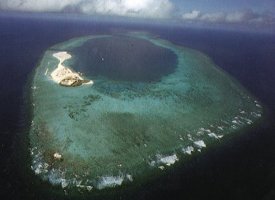 Some of the Spratlys [2]
Some of the Spratlys [2]
October 1936:
Paracels. French and British Admiralties are concerned that Japan may occupy China's Hainan Island and challenge the security of French Indochina, the British Crown Colony of Hong Kong and the Western Powers' naval hegemony in the South China Sea. France is also concerned that Japan may establish a military presence in the Paracels.
February 1937:
Paracels. An unidentified French warship visits the Paracels and reports the islands could serve as a point for Japanese southward expansion. The proximity of the Paracels to the coast of French Indochina would make a Japanese presence intolerable.
April 1937:
Paracels. Britain urges France to occupy the Paracels with French Indochinese. Britain sends survey ship HMS HERALD (ex-minesweeper MERRY HAMPTON, later IJN HEIYO) to look for a suitable place to construct an airfield.
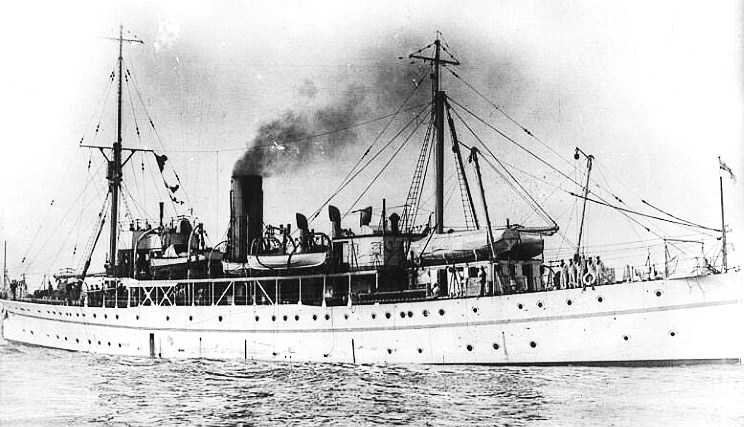 (HMS HERALD, later IJN HEIYO)
(HMS HERALD, later IJN HEIYO)
2 July 1937:
Spratlys. The British Air Ministry reports a Japanese presence on Spratly and Itu Aba, the two largest islands in the Spratlys claimed by French Indochina. Thereafter, the Admiralty and Air Ministry develop a proposal to ask the French to lease either Itu Aba or Thitu so that the British may construct an airfield. They are the only suitable islands, since during the Monsoon season all the others are under water.
September 1937:
Pratas Island. NE South China Sea. The IJN occupies China's Pratas (Dongsha) Island located 211 miles SE of Hong Kong and 528 miles SW west of Taipei, Formosa. The coral island is made up of atolls and reef flats. The IJN later uses Pratas as a weather station and listening outpost. [3]
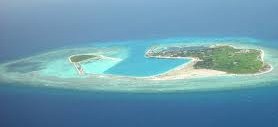 Pratas Island
Pratas Island
1938:
Spratlys. Hydrographic survey vessel (ex-minelayer) IJN KATSURIKI surveys the Spratly Islands, probably to determine their potential naval value.
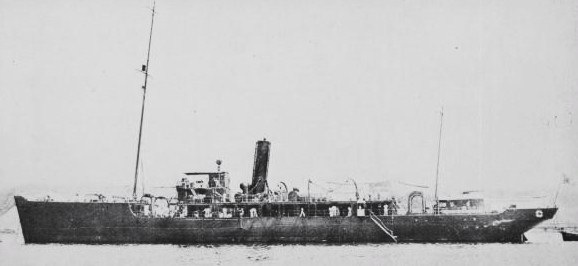 IJN KATSURIKI
IJN KATSURIKI
3 July 1938:
Paracels. French military units, composed of Vietnamese soldiers (Garde Indochinoise), occupy the Paracels. France annexes the islands as part of French Indochina, despite Nationalist Chinese protests. Japan lodges a diplomatic protest with France against the occupation.
30 March 1939:
Spratlys. Japan occupies, annexes and renames the Spratly Islands "Shinnan Shoto "(New Southern Islands) and places them under the Governor-General of Formosa. Later, the IJN establishes a seaplane base and a submarine base at Itu Aba (Nagashima -"Long Island") the largest of the Spratly Islands. [4][5]
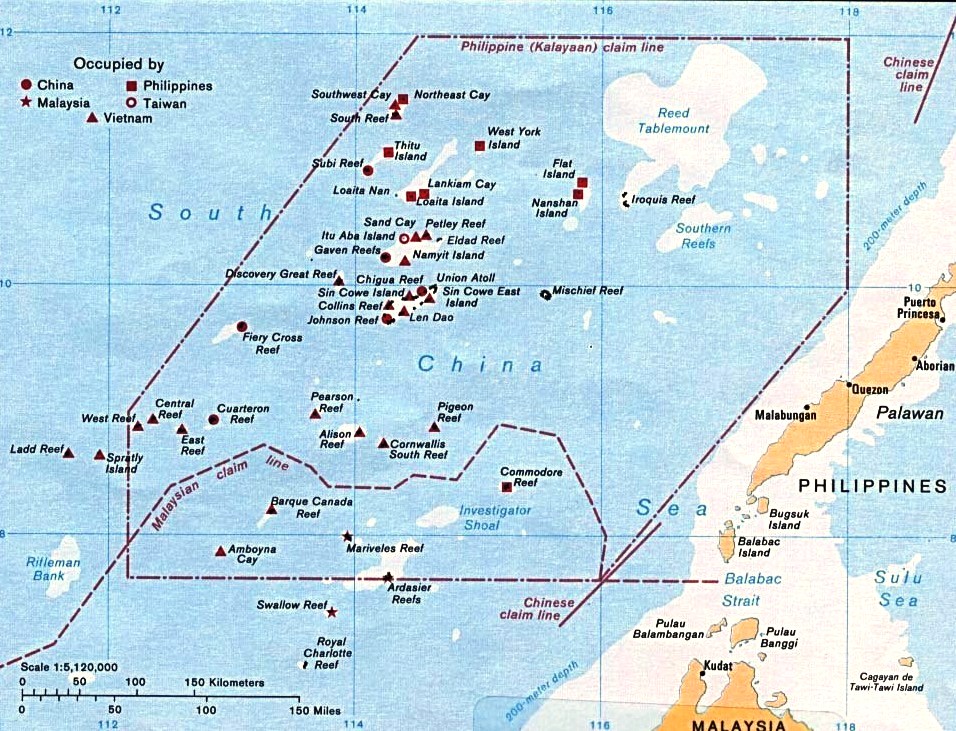 Detail of the Spratly Islands showing Spratly and Itu Aba
Detail of the Spratly Islands showing Spratly and Itu Aba
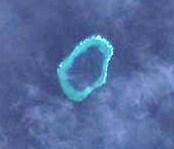 Spratly's Bombay Shoal where USS DARTER had to be abandoned [6]
Spratly's Bombay Shoal where USS DARTER had to be abandoned [6]
4 April 1939:
Paracels. Japanese troops invade the Paracels. Japan claims the islands were Chinese territory and that Japan is at war with China. Japan then declares the islands as a Japanese Protectorate.
1941:
Paracels. Japan places the Paracels under the Governor-General of Formosa to be administered by Japanese authorities at Takao.
Authors' Notes:
[1] Since the 18th century, and probably earlier, the Empire of Annam (later Vietnam) claimed the Paracel (Hoang Sa) Islands.
Territorial disputes by China, Taiwan and Vietnam to the area exist to this day.
[2] China, Malayasia, Taiwan, Vietnam and the Philippines have similarly contested sovreignity claims to the Spratly Islands.
[3] Shinnan Shoto was also known as Shinnan Gunto.
[4] The extent to which the IJN improved facilities in the Spratlys is unclear; however, in Nov ’44, the islands were visited by battleship HARUNA, cruisers HAGURO and ASHIGARA and DesDiv 43's KIRI and UME and joined CarDiv 4's hybrid battleship/carriers ISE and HYUGA and DesDiv 61's SHIMOTSUKI that were already there unloading troops and supplies after being diverted from Manila. Soon thereafter, DesDiv 2's ASASHIMO, DesDiv 7's KASUMI and USHIO and DesDiv 21's HATSUSHIMO also arrved in the Spratlys.
[5] On 29 May '45, USS BLUEGILL (SS-242) landed Australian commandos and American naval personnel on Pratas Island. They destroyed a radio tower, weather station, fuel, ammo dump and several buildings, but no lives were lost as the island's occupants had fled days before. The American flag was raised, the island renamed Bluegill Island and declared United States territory. Later, Pratas Island was returned to the Nationalist Republic of China's Guangdong Province.
[6] Spratly Islands. On 23 Oct ’44, Cdr (later Captain) David H. McClintock's (USNA '35) DARTER (SS-227) after sinking Vice Admiral Kurita Takeo's (38) flagship heavy cruiser ATAGO during The Battle of the Palawan Passage runs DARTER hard aground on the largely uncharted Bombay Shoal (located at 09-26N, 116-55E) attempting to gain position to re-attack heavy cruiser TAKAO that earlier he hit with two torpedoes and set afire. DARTER has to be abandoned, but Cdr (later Captain) Bladen D. Clagett's (USNA '35) DACE (SS-224) braves the reef and rescues DARTER's crew.
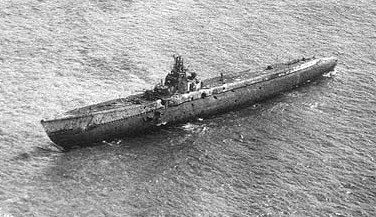
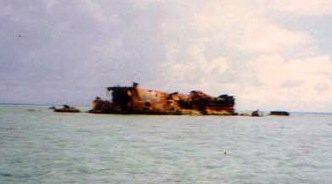 DARTER aground on Bombay Shoal in '44 (L) and in '98 (R)
Author's Notes:
DARTER aground on Bombay Shoal in '44 (L) and in '98 (R)
Author's Notes:
[1] Thanks go to readers "Puddleg", Tom Chambers, Steven Cochran and others for clarifying "Bombay Shoal" vs. "Bombay Reef" in Rev 1.
[2] DARTER is still aground on the shoal in 2012. See DARTER
-Bob Hackett, Sander Kingsepp and Anthony Tully
Back to Rising
Storm Page














